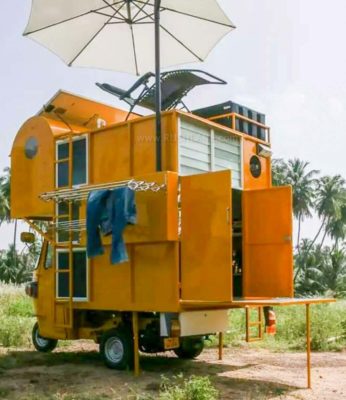Melvin Durai
I live in a medium-sized home, but some people might consider it a large home, and Mukesh Ambani might consider it a broom closet. A billionaire like him would probably find my home small, but it certainly isn’t tiny, especially compared to all the mini-homes that creative people such as Arun Prabhu are designing.
The Tamil Nadu architect built a home that’s so small, it sits atop an auto-rickshaw. The portable, detachable home has two levels, as well as a terrace, each side measuring just six feet in length. The house was designed for just one occupant, preferably a small person. If you’re a sumo wrestler, this house is not meant for you, unless you’re looking for something to bounce on your stomach.
Like most tiny houses, Prabhu’s house combines rooms to save space. The bedroom, bathroom and kitchen share the first level, which can be quite convenient. If you need to use the toilet while you’re cooking lunch, you can do so without taking your eyes off the stove. If that makes you lose your appetite, it might also ensure that you don’t get too big for your house.
Anand Mahindra, chair of the Mahindra Group, recently tweeted about Prabhu’s design, sharing a few photos and saying, “Apparently Arun did this to demonstrate the power of small spaces. But he was also on to a larger trend: a potential post-pandemic wanderlust & desire to be ‘always mobile.’ I’d like to ask if he’ll design an even more ambitious space atop a Bolero pickup.”
Mahindra is thinking big—he’d like to see if Prabhu can design a home in which Princepal Singh would be able to stretch his legs. If the 6-foot-10 basketball center can fit comfortably into a home above a Bolero pickup, it might be perfect for a family of four.
Prabhu’s house, which he has named Solo 0.1, cost him `1 lakh to build and includes a 600-watt solar panel and a 250-litre water tank, as well as workspace on the second level.
“The idea of Solo 0.1 roots from the condition of slums in our country and from the nomadic tribes and gypsies,” he told Times Now. “I wanted to make something that would take the least amount of space, is habitable, and can be traveled in.”
Mobile homes are nothing new, of course, but while most of the mobile homes in the United States and other countries can be moved around, people usually park such homes permanently in a mobile home park. The only time these homes move, unfortunately, is when a tornado strikes.
The most common way for people to travel around in a house is to rent or buy an RV (recreational vehicle), which has a bedroom, kitchen and living room. While Dad drives the RV across the
country, Mom can be cooking, the kids can be watching TV, and the dogs can be sleeping on the pull-out beds.
Unlike Prabhu’s house, RVs can be quite expensive, a luxury for the privileged rather than shelter for the poor. I like Prabhu’s idea of building a small mobile house that’s affordable. I’ve seen how tiny homes have grown in popularity in many countries, partly because of population density and land scarcity, and partly because many people want relief from paying high monthly rents or mortgages. By moving into tiny homes, they can work fewer hours a day and have more time to tweet about their new lifestyles.
Tiny homes are so popular that IKEA, the Swedish home furniture and décor retailer, has created a Bolo XL model. Among its many features, it boasts a walk-around queen bed. Yes, the home is spacious enough that you can actually walk around your bed!
The Bolo XL is too big to fit on top of an auto-rickshaw, but you can’t have everything in life, can you?
